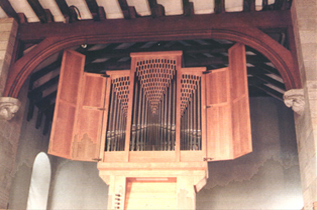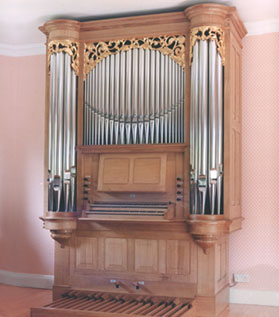
The Answer is Blowing in the Wind
“The organ is nothing more than a machine” – so wrote the late Charles Fisk in notes on a worksheet in 1969. 
The organ builder’s object is to keep it from seeming so. The sounds from an organ will always sound machine-made unless they can appear to be coming from a living organism – “The organ has to seem to be alive”.
The main difference between pipe organs and electronics, or 'electroniums' (to quote the late Dr Donald Wright), is that the organ pipes are fed by wind. An early definition of 'organum' was by John de Trevisa, translated by St Augustine in 1398 as an instrument blown “with bellowes”. Various styles and systems evolved to collect wind under pressure.
Numerous articles have previously been written describing the practical merits of the various styles. However, the notion that all newer developments are bound to be better than the older solutions really must be challenged. We commonly hear that earlier builders arrived at certain points “because they didn’t know any better” – this same argument was applied to tuning temperaments. The thought that Bach wrote the 48 Preludes and Fugues to encourage the use of equal temperament tuning must surely be false. Why explore the characteristics and colours of all the keys if they sounded the same? It’s more likely that he wished to celebrate and exploit musically the tensions and contradictions that occur in a non-equally tempered system.
The musical interaction of sound resulting from the raised wind is what separates out the true organ from any sort of synthesised alternative. The life of the music directly transmitted through the organist’s fingers, along a responsive playing action to the sounds from the organ pipes, depends on a good winding system. Again, Fisk commented: “a good organ will sound both better and worse than a poor one”.
Take for example the usual organ builder’s method of testing a good wind supply – holding a single treble note and then repeating a full chord in the bass. If the note above remains steady, then the organ is said to have good wind supply. Can you imagine how many orchestral woodwind and brass players would manage to hold a note steady if repeatedly pummelled in their diaphragms? We venerate historic organs for their musicality, yet none would pass this sort of wind supply test.
If we have supposedly “improved” our understanding of winding dynamics, and can calculate wind consumptions, why are instruments such as the Goetteborg Go-Art organ, with its extensive research, still produced with winding systems which are effectively three different configurations of bellows and windtrunking in the one instrument?
In virtually all untouched instruments built before 1850, the winding systems are unsteady or 'live' by our standards. It’s only in the 20th century that it’s been possible to obtain steady wind by means of electric blower motors and schwimmer systems. Many organists find such systems rather hard and unforgiving.
Fisk again: “the very variableness of the effect of the wind upon music of diverse kinds suggests the instrument has a temper, that it likes one player but not another, one composer and not another. It seems alive. You even seem to hear it breathing.” Quite apart from the reaction of the winding system to the music played on the organ, the tremulant obviously has a part to play in enhancing the musicality of the instrument. This is clearly a matter of taste – some tremulants, by our conservative standards, may seem to some to be rather over the top, but if we’re not careful, a modern winding system with more precisely controlled tremulants can sound rather clinical.
 Yet a live winding system and a natural Dom Bedos style tremulant located directly in the windtrunk and so responding to the wind consumption and flow, will have subtle differences on different notes. For example, it is possible to achieve a reduction in the pulse speed at the end of a piece as the music resolves.
Yet a live winding system and a natural Dom Bedos style tremulant located directly in the windtrunk and so responding to the wind consumption and flow, will have subtle differences on different notes. For example, it is possible to achieve a reduction in the pulse speed at the end of a piece as the music resolves.
Coming back to Fisk, in an article entitled “The organ’s breath of life”, he comments: “what about the tuning of organs? Our current concern over fine tuning presumes a very steady wind supply originating with an electric blower but with the ancients there was a bellows boy whose every bored indiscretion no doubt shook the wind to the tuner’s distraction, and there was a variation in pressure due to the fact that a bellows’ pressure increases between the nearly open position and the nearly closed.” So why should we even consider wedge type bellows when they’ve been superceded by double rise parallel bellows or indeed modern schwimmer bellows?
Fisk again: “Recall that in a modern organ the bothersome thing about a mixture note out of tune is every time the note returns in the music you’re subjected to the same burble, and after a while it “gets to you” - you become sensitised to that note. Now suppose that instead of being rock steady, the wind system is full of all sorts of ripple, partly due to the pulses of valves opening and closing, and partly due to manual organ blowing. This ripple causes, in all notes of the mixture, burbles which appear to combine with the burbles of detuning, but because they add a random component, the mind does not become sensitised – the mind can see through the defect and is therefore free to concentrate on the music.”
If you have a live winding system, it will understandably have perameters. A foot-blown system will offer a yet more limited set of boundaries but if these are exploited rather than complained about, the music should still win through. Organs without blower motors require careful handling, but legato playing is still possible.
It could be argued that much musical ornamentation evolved because the reaction of winding systems and organ pipe speech articulates what is in effect a weakness in the winding response time of the bellows systems as notes are played.
Finally, we’re told that the reason one should opt for equal temperament and consequently steady winding is because the more obscure key signatures are unplayable in unequal temperaments. I would argue that there is more of a tuning conflict of tempered unison ranks against purely tuned mixtures in equal temperament. I would argue that playing in more extreme keys is more comfortable in unequal temperament aided by a flexible winding system than in equal temperament with a modern, steady winding system.
My last employer, the late Gerhard Brunzema, once commented “to attempt to build organs “well adapted for human hearing...” is based on the theory that the human ear has functioned for millions of years mainly as a warning device, developing extreme sensitivity to minute variations of sound and tiny levels of contrast. Utmost stability and rigidity of sound, indeed any kind of steadiness or same-ness, causes lack of interest and boredom in the listener. Thus, Brunzema organs are winded by reservoirs without regulating systems such as schwimmers”.
I don’t claim to have all the answers to this issue but hopefully we attempt to produce musicality in our instruments. If we’re to retain a musical upper hand over the competition from electronic substitutes, the answer is blowing in the wind!